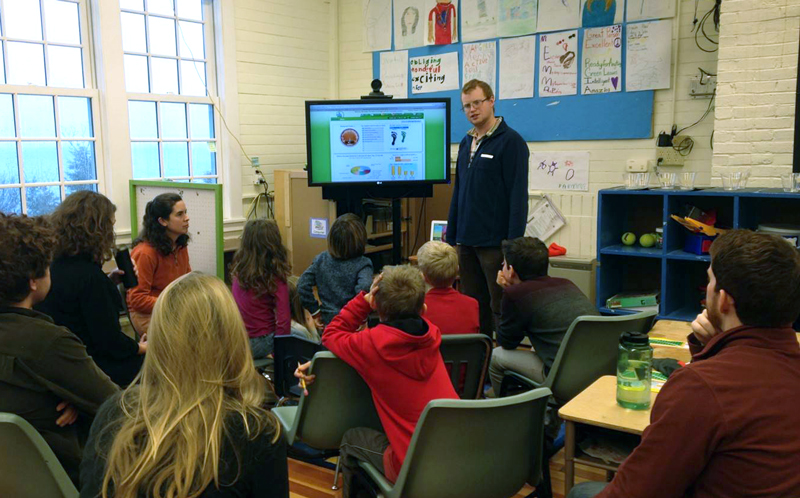The Monhegan Community Energy Action Team (CEAT) was created to serve a simple purpose: help people in the community lower the cost and environmental impact of their energy use through education about energy efficiency and conservation, and renewable energy. The importance of this goal cannot be overstated; Monhegan residents pay some of the highest costs per unit of energy in the country. As the incoming island fellow, I was tasked with coordinating the team. Our first task was to teach the students in the Monhegan Island School about energy: what it was, how it was used, and how their behavior could impact their energy use.
On a bitterly cold afternoon in January, we held “Energy Day” at the Monhegan School house, to do just that. Suzanne, Brooks, and Harry from the Island Institute were on hand to go over energy basics with the kids. After a few activities, I took over to introduce the students to the eMonitor – a device that measures power use in a building, in real time, and broken down by circuit. It stores and displays this information on a website as a series of graphs.
I walked through each graph with the students, explaining what it measured, trying to get them to think about how it changed over time, and how their actions might affect it. There was one graph that showed the real time use on each circuit, one that showed use over time, one that translated their electricity use into a “carbon footprint,” and one that showed the “phantom power” use (power being drawn from electronics that are plugged in but not turned on) over the last month.
While these can be tough concepts to understand, it seemed like they were getting it. So I issued a challenge to the students: Use the eMonitor to track their energy use for a month, and try different strategies that they thought would save energy. If they saved enough money on the school’s electricity bills, they would get a pizza party to celebrate.
A month later, I called into the Monhegan School from the Island Institute office, using a video conferencing unit. It was 2:30, on the day before their vacation, and I could tell the kids were ready to get out the door. I was also excited, but for a different reason. I had been following their progress throughout the month and was blown away by what I saw: In just a month, the one-room schoolhouse had used 125 kWh less electricity, which translated to a total savings of $87.50 for the school.
I asked them what strategies they used to lower their energy use. They had tried a couple different things, but the big one was turning off the two of the three overhead light strips, so that only the part of the room furthest from the windows was illuminated by electric light. The rest of the room, as the students discovered, could be adequately lit by the natural light from outside, even on cloudy days. They also learned that if they turned down the heater at night, the fan inside the unit would use less electricity, and that if they unplugged the printer when it wasn’t in use, it wouldn’t draw power needlessly. They had literally thought of every possible way, no matter how trivial or obscure, to save power in their school.
Needless to say, they got their pizza party.


